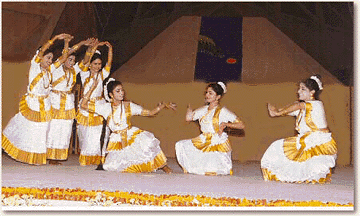|
|
Mohiniyattam
|
| The dance of the enchantress, Mohiniyattam is a female classical dance form of
Kerala. It was mainly performed in the Temple precincts of Kerala. It is also the heir to
devadasi dance heritage like Bharatanatyam, Kuchipudi and Odissi. The word Mohini means a
maiden who enacts desire or steals the heart of the onlookers. There is a well known story
of Lord Vishnu taking on the guise of a mohini to enthrall people, both in
connection with the churning of the milk ocean and with the episode of slaying of Bhasmasura

Poet Vallathol revived this art form, which once witnessed a great downfall. He gave it
a status in modern times through Kerala Kalamandalam, which he founded in 1930.
Kalamandalam Kalyaniamma, the first dance teacher of Kalamandalam was instrumental in
resuscitating this ancient art form. Along with her, Krishna Pannicker, Madhavi Amma and
Chinnammu Amma, the last links of a disappearing tradition, nurtured aspirants in the
discipline at Kalamandalam.
Mohiniyattam is based on the themes of love and devotion and more often the hero is Vishnu
or Krishna. The audience can feel his invisible presence when the heroine or her
maid details dreams and ambitions through the circular movements, delicate footsteps and
subtle expressions. The movements are graceful like Odissi and the costumes sober and
attractive.
The repertoire of Mohiniyattam follows closely that of Bharatanatyam. Beginning with
Chollikettu, the dancer performs Jathiswaram, Varnam, Padam and Thillana in a concert.
Mohiniyattam like many other forms follows the Hasthalakshana Deepika as a text
book of hand gestures. The style of vocal music for Mohiniyattam is classical Karnatic. |
|
|
|
|
| |
|
|
|
|
|
 Indian Classical Dances
Indian Classical Dances
India has one of the richest cultural heritages in the
world. Its classical dance traditions date back 2000 years. Indian classical dance is a
synthesis of many arts.
 Bharathanatyam
Bharathanatyam
This dance which originated in the temples of TamilNadu,
specially from Tanjore and Chidambaram, was performed by Devadasi's in the olden days.
Graceful movements, mime, and music contribute in equal measure to this beautiful dance
from the South. The distinguishing features of "Bharat Natyam" are the noble,
almost geometrical angularity of movements and forceful foot-work.
 Mohiniyattam
Mohiniyattam
Mohini Attam or the dance of the Enchantress, originated in
the Southern most state of Kerala. This dance, unlike the other 2 South Indian styles, has
wide and swaying movements of the body and 15 more sensuous in style.
 Kathakali
Kathakali
One of the major Dance drams styles of India, has originated
from the lush, green Southern most state of India - Kerala. A traditional Kathakali
performance lasts all night and tells stories of heroes and heroines, Gods & Demons
from the Indian epics, Mahabharata and Ramayana. The techniques of Kathakali are extermly
complicated and the dancers, mainly men, excute rapid spins, leaps and freezes with split
second timings.
 Odissi
Odissi
Orissa, on the Eastern Sea-Coast of India, is the home of
the highly sensuous and lyrical form of dance called Odissi. This state is famous for its
temples, the Konarak, dedicated to the Sun God, The Jagannath Temple of Puri and many
more. The main features of this dance are its postures and sculpturous positions, closely
relating to the sculptures of the famous temples of Orissa. The Odissi dancer bends the
hips and sways the torso in curves and flexions known as "Tribhangi" (Triple
Bend) and "Atibhangi" (Semi-circular bend) from the torso downwards.
 Kathak
Kathak
A major solo style of Northern India, Kathak has
traditionally been danced by both men and women. This dance originated from the Braj
region in Uttar Pradesh by "Kathakars" or story tellers. With the advent of
Moghals in the North, Kathak moved from the temples to the courts or darbars of the Kings.
Thus this is the only dance where there is fusion of Hindu & Muslim culture. The
distinctive feature of Kathak is its brilliant foot-work, and an even motion with a rapid
tempo, the beauty and grace of movement is retained.
 Kuchipudi
Kuchipudi
Similar in many ways to BharatNatyam, this dance style which
originated as a ballet form of dance, from the village named Kuchupudi in AndhraPradesh,
has its own distinctive music and a more plastic or fluid line. It is only in recent times
that Kuchupudi has began to be performed solo and by Women.
 Manipuri
Manipuri
Manipur is located in the North Eastern part of Indian,
surrounded by mountain ranges, is famous for Manipuri dances, which is mainly devotional.
Lyrical grace, lightness of tread and delicacy of hand gestures, set Manipuri dance apart
from the geometric structure of BharatNatyam and the linear quality of Kathak. There are
also some vigorous Thadava or Musculine items called Cholam, in which the dancer leaps,
whirls and spins on the floor, while keeping rhythm on the drums slung from his neck.
 Links
Links
Here you will find a lot of other web sites related to
Indian Classical Dances. We really appreciate for visiting us.